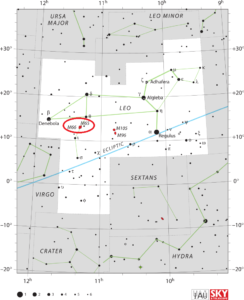Messier 66, the brightest and largest member of the Leo Triplet of galaxies, is an intermediate spiral galaxy located in Leo constellation. It was discovered by French astronomer Charles Messier[8] on March 1, 1780, who described it as “very long and very faint”. This galaxy is a member of a small group of galaxies that includes M65 and NGC 3628, known as the Leo Triplet, or the M66 Group. M65 and M66 make a popular pair for observers, being separated by only 20′.
| Description | |
| Visible From Pacific Northwest | January, to May |
| Best Time To Observe | April, March, and May |
| Minimum Size Of Viewing Device | Small Telescope |
| Object Type | Spiral Galaxy |
| Designations | Messier 66, M66, NGC 3627, Arp 16, PGC 34695, UGC 6346, Ark 288, IRAS F11176+1315, 2MASX J11201502+1259286, MCG+02-29-019, RGB J1120.3+1259, VV 308a, Z 1117.6+1316 |
| Right Ascension | 11h 20m 15s |
| Declination | +12°59’30” |
| Constellation | Leo |
| Number Of Stars | 200 billion |
| Apparent magnitude | +8.9 |
| Apparent dimensions | 9′.1 x 4′.2 |
| Object Radius | 47,500 light years |
| Distance From Earth | 36 million light years |
History
Messier 66 is one of Charles Messier’s original discoveries. The comet hunter found it together with its neighbour M65 on March 1, 1780 and added both objects to his catalogue. The third member of the M66 Group, NGC 3628, was not discovered until April 8, 1784, when William Herschel found it with his telescope, which was considerably larger than the one Messier used.
Messier described M66 as a “nebula discovered in Leo,” adding that “its light is very faint & it is very close to the preceding [Messier 65]: They both appear in the same field in the refractor. The comet of 1773 & 1774 has passed between these two nebulae on November 1 to 2, 1773. M. Messier didn’t see them at that time, no doubt, because of the light of the comet.”
William Herschel observed M66 in April 1784 and described it as a bright, much extended “nebula of irregular figure,” adding that “the extension is chiefly in the direction of the meridian and the greatest brightness near the middle.”
John Herschel catalogued the object as h 857 and later added it to the General Catalogue as GC 2377. He noted, “Bright; very large; much extended in position angle 150 degrees; much brighter toward the middle; 2 stars north preceding [NW].”
Locating M66 In The Sky
The Leo Triplet can be found between the stars Theta and Iota Leonis, or along the line from the bright star Denebola to Regulus, the brightest star in Leo.
M66 is the easternmost of the two Messier galaxies in the group. It lies only 0.33 degrees to the southeast of M65, which is located about 3 degrees to the south-southeast of Theta Leonis.

Viewing M66
Messier 66 and Messier 65 are visible even in small binoculars, which reveal two fuzzy patches of light, Small telescopes will show the galaxies’ oval shapes and brighter centres. Medium-sized telescopes will reveal the bright cores more clearly, while 10-inch and larger telescopes will show hints of the spiral arms. The best time of year to observe M66 is during the months of March, April and May.
Photographing M66
It is possible to obtain the Leo Triplet into 1 image, which is M65, M66, and NGC 3628. When photographing the Leo Triplet, make sure that the camera being utilized is accurately aimed so that all three are comfortably in the shot. The Leo Triplet is a bit more sophisticated than a single galaxy as there are 3 galaxies in this image, but they can be imaged together using almost any sized telescope. All 3 galaxies are similar in brightness, color, and size, which makes editing easier than one would expect from multiple objects in the same image.
https://www.galactic-hunter.com/post/leotriplet
Sources And Further Reading
Descriptions of all of Messier Objects can be found here.
https://www.nasa.gov/feature/goddard/2017/messier-66
http://www.messier.seds.org/m/m066.html
https://freestarcharts.com/messier-66

Be the first to comment on "Messier 66"